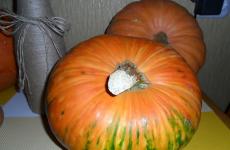Running wheel for a hamster by hand. Hamster running wheels
Hamsters are very cute and easy to care for pets. With the right content, they do not cause their owners almost any trouble. Because of their small size, hamsters are kept in cages or in special small houses. However, do not forget about the natural needs of the animal in sufficient physical activity. In order to enable the pet to be active, various attractions are installed in the home of domestic hamsters. The article will discuss how to make a wheel for a hamster with your own hands.
Why do you need a trainer?
Hamsters, by nature, are nocturnal rodents. Under natural conditions, the animals run long distances in order to feed themselves. Hamsters kept at home are deprived of this opportunity. In addition, there is simply no special need to independently search for and obtain food, because the owner provides timely and sufficient feeding to the pet.
But despite favorable conditions and satiety, hamsters still need to get exercise periodically. This is necessary not only for the entertainment of the animal, but also to maintain the health of its cardiovascular system. Regular physical exercise stimulate the metabolism and metabolism of the rodent, help to keep the muscular system in good shape.


And in the conditions of a small cage, it is necessary to give the hamster the opportunity to move around, because it is not safe to let him go for a free walk. because of small size the animal is not very visible, and it can be accidentally injured. But also other pets can be dangerous for hamsters: cats, dogs, large parrots.
A convenient and safe solution to this problem is to install a running wheel directly into the pet's home. Hamsters quickly understand how to use it, if they wish, they can climb onto the simulator at any time and run around.
The only downside is that Hamster is a nocturnal animal. That is, its activity in most cases falls on the time of day when we are used to sleep. Therefore, active night runs can disturb the inhabitants of the apartment if the wheel creaks or makes a knock.
Manufacturers are trying to produce silent rides for rodents. However, a running wheel that does not make loud sounds can also be made at home.


Manufacturing
Before you start making an attraction for your pet, you should at least in general terms figure out what a jogging wheel should be.
- The attraction must be the right size. The animal should not be cramped inside, otherwise it will not be able to move comfortably. Too large dimensions of the running structure are also undesirable. It will be very difficult for a hamster to turn such a wheel with his paws. For an adult Djungarian hamster, a diameter of 14-16 cm is suitable. It is better for animals of the Syrian breed to make a larger attraction, as they are larger. For an adult, the diameter of the circle must be at least 20 cm.
- The width of the treadmill also matters. If it is not wide enough, the hamster will periodically fall and may be injured. For small and medium-sized individuals, it is better to make a simulator 5 cm wide. For larger breeds, a track width of 7-8 cm is recommended.
- The running wheel should spin easily. Otherwise, the animal will quickly get tired and may lose interest in its attraction.
- It is worth taking care that the pet does not injure its paws during classes. It directly depends on the material and surface structure of the running track. If you decide to use mesh materials, then make sure that the cells are as small as possible. Otherwise, while running, a hamster's foot may get stuck in them. And also on the simulator there should not be sharp notches or bumps that the hamster can stumble on.
- The treadmill inside the wheel must not be slippery. Therefore, a smooth plastic surface should be pasted over with a thick cloth in advance. For her, the pet will be able to cling to claws.
- When installing a wheel, make sure it is securely fastened.. The animal moves on the track quite intensively, and the shaky structure can tip over during its run. Therefore, the treadmill must be attached to the bars of the cage or placed on a solid and stable support.


For the manufacture of the wheel, you can use various materials at hand.
From plastic bottles
Necessary materials: a large round plastic bottle, a nail, a dowel with a diameter of 1 cm, a strip of dense fabric.
- measure 7-8 cm from the bottom of the bottle and cut it at this level;
- make a hole in the center of the bottom of the cut container and insert the head of the prepared nail into it;
- insert the nail into the dowel;
- cover the slippery surface of the bottle with a thick cloth;
- attach homemade wheel to the bars of the cage with a dowel.

A simple cardboard option
For manufacturing, you need to prepare a strong knitting needle, a sheet of thick cardboard, glue, a ruler, scissors.
The workflow includes several steps.
- Draw two identical circles on the cardboard with a compass and cut them out. They will serve as walls on both sides of the track.
- On circles with scissors, make 2-3 square or round windows. Their dimensions should be slightly larger than the size of your pet. Through these holes, the hamster will be able to make his way inside his running wheel.
- From the remaining cardboard, cut a long strip 5-7 cm wide. This will be the attraction track.
- Glue a strip of cardboard between the two circles. Let the glue dry and hold the parts together well.
- Determine the center of the circle and pierce both walls with a knitting needle in this place.
- The resulting wheel can be placed on a support or attached to the wall of a house or cage with a flexible wire.

A hamster wheel is a great play attraction on which the animal can have fun and stretch. The type of simulator you choose for your pet will depend on its safety, comfort and health, because the pet not only sleeps, but also likes to frolic with high quality.

There are many varieties of hamster wheels - for every taste and budget, you are able to make such a simulator yourself. The fact is that not all simulators are suitable for the size of the cage and the pet. The main role in choosing a toy for a rodent is played by the diameter of the wheel.
The choice of simulator
The diameter of the wheel for different breeds of hamsters will be different: for Dzungarian hamsters it will be 16-18 cm, and for adult Syrian hamsters, the diameter will be 20-22 cm. The circle should be large and spacious so that the animal can move comfortably. If the wheel is small in diameter and narrow, then the hamster will strongly bend down and stumble, which can lead to dislocation or fracture.
When choosing a simulator, pay attention to the surface of the track: on the lattice surface, the animal can fail and make a wound on the paw. It is advisable to buy or make a wheel yourself from a solid sheet of iron or plastic with small notches for grip. If you wish, you can even build an illuminated wheel for your pet.
The safest will be simulators made of iron with a small distance between the bars or solid wood wheels. If the structure is made of wood, you can not worry about the safety of your hamster even if he gnaws through the material of the simulator.
Another precaution will not hurt if the animal has a simulator on a stand. It should be placed approximately in the middle of the cage a few centimeters above the bottom. These steps will help you avoid injury.
Types of simulator and mounts
There are several types of running wheel trainer for hamsters: wooden, cardboard and silent. In addition to the materials from which they will be made, it is important to pay attention to the mounting of the simulator.
- Fasteners to the cage wall: it is performed using special fasteners or strong wire. The advantage of the method is saving space in the pet's home, and the minus is the noise from the simulator.
- A running toy with fasteners at the bottom of the cage.
- Another type is a running disc, which is best in terms of its stability; it is an analogue of an ordinary simulator.
Silent
How to make a hamster wheel with your own hands? A silent wheel for your hamster is a great option not only for fidgety furry, but also for owners who want to minimize the noise from their pet. To make a silent hamster wheel with your own hands, you will need:
- bearing;
- can;
- insulating tape;
- upholstery fabric;
- glue;
- wire.

So, let's start assembling our simulator. We take scissors for metal and cut off a sheet from a can, the height from the edge should be 8-10 cm. Glue the bearing to the bottom of the resulting wheel, wait for the glue to dry. We line the entire surface with polystyrene foam - it will make the treadmill of your animal silent. We make the width of the sheet of fabric according to the volume of the cut of the can and bend it, hiding the sharp edges. We grab the fabric on top of the tin with electrical tape. Attach the resulting metal base to the cage with a wire. As you can see, making a hamster wheel with your own hands is very simple, even children can do such an exciting thing.
Cardboard
If you find out how much it costs to buy a simulator and decide that it is not affordable for you, you need to make a toy yourself at home. The best wheels are made of cardboard, they are convenient to accustom the hamster to training. This design is safe and does not creak.
So, let's start the assembly. To build a toy, we need to make two circles out of cardboard, the size of which corresponds to the parameters of your pet. On one of the circles we cut out a passage for the hamster. Next, in a circle, we make small notches in the form of triangles along the edges. We will also cut out the wall and base to which the circle will be attached. The track should be cut in accordance with the rectangular cutouts on the circles.
Assembling the cardboard structure:
- we insert the track so that the protrusions on it are intertwined with the holes made;
- fix the base behind the wall;
- insert a metal sleeve;
- take the sleeve and put on it one wheel, and then the second.
The main disadvantage of this method is that the cardboard is short-lived and can be eaten by animals. Advantages - cheapness and ease of preparation at home.
Wood
If you have the talent of a carpenter, then you can with my own hands make wooden product. A circle made of such material has more lines of use. The deal of a wooden attraction is very clear, it is similar in everything to a cardboard assembly. If desired, you can decorate the product: beautifully intertwine with a vine or willow.
Caring for hamsters is no big deal. It is important to remember that this is an active animal and you need to provide for it good level activities to keep fit. Favorite toy is a hamster wheel. It is necessary for the animal not only for entertainment, but also as a universal simulator to support muscles in good shape. At the same time, a running wheel for a hamster must be selected taking into account the size of the animal and its breed.
Why does the animal need a wheel
For hamsters, silent wheels are very important, because in nature this animal runs up to 10 km in search of food in one night. Therefore, a special wheel simulator will help to give an outlet of energy to a small animal. In this case, it is necessary to take into account where this device will stand, since the animal can run through it all night, which can create extraneous noise. How the hamster moves in the wheel can be seen in the photo.
How to choose a hamster wheel
The wheel for any hamster is a wide circle, inside which the animal runs. Such products differ in material, size and cost of the product. The simulator can be made of the following materials:
- Wood products are not so common due to the high cost. But a pet will be able to gnaw on such material without much concern.
- Popular Treadmill stainless steel, which belongs to the budget options. This option is characterized by special strength.
- Plastic products are presented in a wide range.
 You can make a simulator for rodents with your own hands. In doing so, a number of points must be taken into account. For example, the requirements for the work surface. If it is trellised, then the animal may be injured. The mesh should be fine so that the paw of the animal does not disappear there. Additionally, it can be made safer with cardboard. There are even special non-slip surfaces.
You can make a simulator for rodents with your own hands. In doing so, a number of points must be taken into account. For example, the requirements for the work surface. If it is trellised, then the animal may be injured. The mesh should be fine so that the paw of the animal does not disappear there. Additionally, it can be made safer with cardboard. There are even special non-slip surfaces.
It is also worth considering and secure fastenings. Fixing the structure between the bars is considered safer. But the model on the stand can lead to injury. If the cage allows, then instead of the standard option, you can purchase a running circle.
Important! It is necessary to pay attention that the product spins well, and is also safe for the animal.
Which simulator to choose depending on the type of animal
When choosing the size of the product, it is worth considering the breed of hamsters. For the Djungarian hamster, it is better to choose a small wheel. Its diameter should be 14-16 cm.
For a Syrian hamster, you will need a large simulator. Its diameter should not be less than 18 cm. And it is better if it is 20-24 cm.
The width of the track also matters. For the jungrik, the width of the device should be 5 cm, and for the Syrian - 7 cm. If the track is too narrow, the animal may fall off the simulator.
Varieties according to the method of attachment
Simulators for a small pet come in three types:
- With fastening on the cage wall using wire or special holders. At the same time, such a simulator saves cell space.
- Model on a stand. This option does not have good stability.
- A product with wheels on a stand is a safer design. In this case, the wheels are located on the stand.
- A stable stand is equipped with a running disc.
 After a short period of use, the simulators may create extraneous noise. In this case metal structure can be lubricated vegetable oil. Some masters create simulators with a generator. This device is used to charge a mobile phone.
After a short period of use, the simulators may create extraneous noise. In this case metal structure can be lubricated vegetable oil. Some masters create simulators with a generator. This device is used to charge a mobile phone.
To reduce noise, you can replace the plastic fasteners with a bearing. In this case, the simulator will not produce noise.
How to make a simple DIY hamster wheel

You can build a running wheel for any hamster with your own hands. After all, this is a great opportunity to get an inexpensive, but high-quality simulator. In addition, you can make the product according to your desires. There is no need to purchase special materials.
You can make a silent hamster wheel out of plywood. To do this, cut out two identical circles from the sheet. The diameter of the circle should be equal to the diameter of the future product. Both parts are interconnected with twigs. Such a product makes less noise than similar options.
 They make a hamster a running structure from a hard computer drive. How it looks can be seen in the photo.
They make a hamster a running structure from a hard computer drive. How it looks can be seen in the photo.
To prevent the simulator from making noise, you can make a hamster wheel on a special bearing.
Here's an easy way out of the box of disks:
- In the disc box, you need to measure 5 cm from the top, and then draw a straight line around the circumference.
- Along the line, it is necessary to cut with a jigsaw.
- Then, using a drill, holes are drilled at a distance of 0.5 cm.
- At the place of the cut, it is necessary to perform grinding with a sandpaper.
You can make other accessories for hamsters with your own hands. From plastic bottles It turns out an unusual labyrinth for a hamster.
From improvised materials, you can build a practical and convenient product for active pet activities. It is important to correctly calculate the dimensions and choose the material for a high-quality wheel.
Accessories in a hamster cage are very important, especially when purchasing or constructing a running wheel that will allow the animal to use up the accumulated energy of the day. This article will discuss the basic requirements for a running wheel, what hamsters use it for and how to make such an accessory at home.
Why do hamsters run on a wheel
In the wild, hamsters travel tens of kilometers a day to feed themselves, so purchasing or designing a wheel and installing it in a cage will allow your pet to do what they love, since hamsters are quite mobile animals.
As you know, they constantly eat and love this business very much, therefore, without sufficient activity, the animal can eat up to an impressive size, which will make it inactive. The minimum activity of the hamster entails serious problems with health, and for a long time the animal will not live in such a situation.
The best option to ensure that the animal is constantly in motion is to purchase a running wheel. 
General requirements for an accessory
When purchasing a treadmill or constructing it yourself, it is necessary to take into account the mandatory requirements that will allow the animal to use it without much effort.
These requirements include:


How to make a DIY hamster wheel
If you do not want to purchase a hamster treadmill in a store for any reason, you can make it yourself with minimal material and time costs.
To make a running wheel at home, you must use:
- a piece of plywood;
- bamboo wallpaper;
- ruler;
- compass;
- pencil;
- broken hard drive
- sandpaper;
- jigsaw;
- drill;
- a hammer;
- small carnations;
- wire.

Step-by-step instruction
Consider step by step process making a running wheel for a hamster:
- To begin with, we make markings on plywood, draw a circle with a compass, which will serve as the basis for the wheel, and the outer ring for fixation. To do this, we measure a radius of 11 cm, outlining a circle on plywood - this will be the outer ring, then inside the drawn circle, using a compass, draw another circle with a diameter of 10 cm - this will be the basis for the wheel.

- Then you can start cutting out two parts - a ring and a round base. To do this, use a jigsaw. Initially, a large circle with a diameter of 11 cm is cut out, then an inner circle with a smaller diameter of 10 cm is cut out of it.

- To strengthen the structure, you will need another ring with an outer diameter of 12 cm and an inner diameter of 9 cm. After sawing, the inner circle will not be used, one more part of the structure can be cut out of it.

- The inner circle with a diameter of 9 cm, which was obtained after completing the previous step, must be used to cut out a part of the structure that allows the rotation of the wheel and attach it to the cage. To do this, cut out a trapezoid with dimensions: sides - 6 cm, top - 2 cm, bottom - 4 cm. On the bottom of the trapezoid, on each side, we make holes for the wire with which the wheel will be attached to the cage. Thus, along the bottom line of the trapezoid, you will have 2 holes. For the time being, we put this element aside, later it will be finalized.
- The next step is to work with bamboo wallpaper. It is necessary to measure a strip on them: width - 11 cm, length - 66.5 cm. Two such strips need to be cut out in order to glue them together and prevent contact of the hamster with the adhesive base of the wallpaper.
 To glue the strips, use non-toxic wood glue and a regular brush with which it will be applied. We leave the running part of the structure to dry.
To glue the strips, use non-toxic wood glue and a regular brush with which it will be applied. We leave the running part of the structure to dry. 
- In order to obtain the necessary details from hard drive, it needs to be opened. The disk will be needed to remove the bearing from it, which will allow the wheel to rotate, and another element attached to the trapezoidal part of the future structure. This element, which you need to find, has the shape of a crescent with a tail (outside, in the middle).

- We return to the basis of the running wheel. In the center of the base - a circle with a diameter of 10 cm - a hole must be drilled with a drill. Its diameter should correspond to the size of the bearing that was removed from the hard drive.

- We insert the bearing into the prepared hole and work out the place where it comes into contact with plywood, with hot melt adhesive, so that they are firmly connected to each other.

- After that, it is necessary to nail the dried running surface to the base of the running wheel with bearing using small nails and a hammer. To do this, we wrap the base with a running surface so that free space appears inside the structure where the hamster will run. Carnations are driven into the base and end part of the treadmill, connecting them to each other.

- After that, on the open side of the treadmill, we attach a ring with an outer diameter of 11 cm using carnations and a hammer. This element will allow the hamster not to fall out of the structure during the run.

- We fasten the ring with a diameter of 12 cm with nails to the base for more reliable fixation of all elements of the simulator.

- It remains to attach the part from the hard disk (crescent with a tail) to the trapezoid element in such a way that the edges of the crescent are attached to the top of the trapezoid, and the tail is outside. After that, the tail is attached to the bearing at the base of the wheel. It is very important that the wheel rotates easily after being attached to the trapezoidal element.

- All edges of plywood must be treated with sandpaper in order to make the surface of the simulator as smooth as possible, so you will prevent injury to the hamster when using the accessory.
- The final stage is attaching the simulator to the cage. To do this, use a wire. Pass its edges into the holes of the trapezoid element on the back of the wheel and securely fix it on the bars of the cage.
How to teach a hamster to run on a wheel
It is quite difficult to teach a hamster to run on a wheel, especially if the animal does not show interest in the installed accessory. As a rule, rodents immediately actively get acquainted with the new simulator, quickly get used to it.
Important! In order for the animal to quickly learn to run in the wheel and get used to it, it is recommended to purchase this accessory when the hamster is still small.
If, after installing the simulator, the hamster does not show interest in it, it is recommended to help the animal master it using some trick. Initially, the hamster is placed in the simulator and cover the exit with a paper sheet or palm.
A treat is placed inside the structure and they begin to rotate. Thus, the hamster rushes for a treat and learns to use the treadmill for its intended purpose. Usually, after such manipulations, the hamster is happy to return to the simulator every day to run. 
Possible problems
After acquiring or constructing a treadmill, there may be some design problems that cause the hamster to refuse to use the accessory, so let's look at what these problems are, as well as possible ways to solve them.
The wheel creaks
If during operation you notice that the simulator makes extraneous sounds, they can be eliminated by lubricating the axis of the structure olive oil. To do this, take the oil, apply it on a cotton pad and wipe the wheel axle.
It is recommended to remove the remaining oil with a paper towel so that the animal does not get dirty during the operation of the accessory. It is allowed to treat the axis with silicone grease, which is also safe for the animal. 
A hamster does not run on a wheel
Usually rodents are very interested in a new accessory that has appeared in the cage. The animal will definitely try to run on it in the near future. It often happens that after the first use of the accessory, the hamster suddenly completely loses interest in it, so you need to figure out what this is connected with and how to fix this situation.
First of all, it can be inconvenient for a hamster to use the simulator, due to inappropriate wheel sizes: if it is too large, it is inconvenient for the rodent to move on it, if it is too small, the hamster can cling to the back and slide off the track. To avoid such problems, choose a wheel according to the recommended dimensions.
Did you know? Hamsters use their cheeks not only to stuff more food into them, but also to stay on the water. Once in the water, they draw air into their cheek pouches, which allows them to stay on the surface, like a float.
If the structure is poorly attached to the cage, it can rumble and scare the animal, so the hamster will be afraid to use it again. To correct the situation, remove the simulator and attach it again, more securely.  You can recommend the article to your friends!
You can recommend the article to your friends!
You can recommend the article to your friends!






